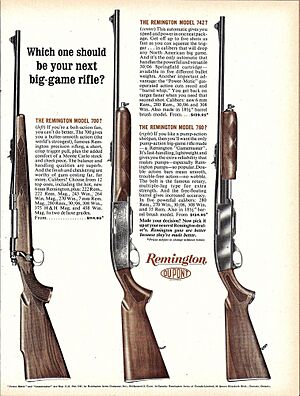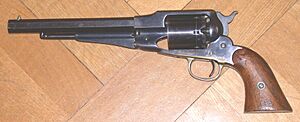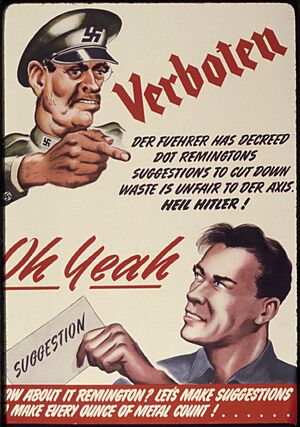Remington Arms facts for kids
 |
|
| Subsidiary | |
| Industry | Arms industry |
| Fate | All assets sold off |
| Successor | Remington Firearms, Remington Ammunition |
| Founded | 1816 |
| Founder | Eliphalet Remington |
| Defunct | 2020 |
| Headquarters |
,
United States
|
|
Area served
|
Worldwide |
|
Key people
|
Anthony Acitelli (CEO) |
| Products | Firearms, ammunition, and accessories |
| Revenue | US$950 million (2004) |
| Parent | Remington Outdoor Company (2007–2020) |
Remington Arms Company, LLC was a famous American company that made firearms (like guns) and ammunition (bullets). It was once owned by the Remington Outdoor Company. However, in 2020, the company faced financial problems and its different parts were sold off.
Today, two new companies carry the Remington name. One makes firearms and is called Remington Firearms, owned by RemArms, LLC.. The other makes ammunition and is called Remington Ammunition, owned by Vista Outdoor Inc.
Eliphalet Remington started the company in 1816 in Ilion, New York. It was one of the oldest gun makers in the United States. In fact, it claimed to be the oldest factory in the country that still made its original product. In 2015, Remington was the biggest maker of rifles in North America. The company also created or used more types of ammunition than any other gun or ammunition maker in the world.
History of Remington Arms
How it Started in the 1800s
The Remington company began in 1816. A young man named Eliphalet Remington II (1793–1861) believed he could build a better gun than he could buy. So, he started making a flintlock rifle for himself. When he was 23, he joined a shooting contest. He came in second, but his well-made gun really impressed the other shooters.
After the contest, Eliphalet received many orders for his guns. This is how he officially started his gun-making business. By 1828, he moved his workshop to Ilion. The modern Remington firearms factory still uses this very same location today.
On March 7, 1888, the Remington family sold their company, E. Remington & Sons. The new owners were Marcellus Hartley and Partners. This group also owned a big sporting goods chain and other gun companies. At this time, the company officially changed its name to the Remington Arms Company.
Remington in the 1900s
When the United States joined World War I, Remington became very important for making weapons. The company produced many guns and ammunition for the war. After the war, Remington had a lot of extra guns and ammunition. The U.S. government bought these firearms from them.
During the Great Depression, a tough economic time, DuPont bought Remington. DuPont was famous for making better gunpowder. A year later, Remington bought another company called the Peters Cartridge Company. Even today, many Remington bullets have "R-P" on them, which stands for Remington-Peters.
In 1940, the U.S. Army worried about having enough ammunition. They asked Remington to help expand ammunition production across the country. With help from DuPont, Remington built several large ammunition plants. Even though these plants belonged to the U.S. government, Remington was asked to manage them. During World War II, Remington also made famous weapons like the M1903A3 Springfield rifle for the government.
In the 1950s and 1960s, Remington started making other products besides guns. They bought a company called Mall Tool Company in 1956. One of the new products they made was chain saws.

In 1962, Remington introduced the Model 700 bolt-action rifle. This rifle became one of Remington's most successful products. Many different versions of it were made. These included the Remington 700 BDL and the Remington 700PSS, which was popular with police and law enforcement agencies. The military also used a version called the M24 SWS as a sniper rifle for many years. Other gun companies even designed their own sniper rifles based on the reliable Remington Model 700.
In 1969, Remington started building a new ammunition factory in Lonoke, Arkansas. By 1970, this factory was making centerfire ammunition. Later, the company moved all its shotshell and rimfire ammunition production to the Lonoke factory.
In 1986, Remington closed its old ammunition factory in Bridgeport, Connecticut. All operations moved to the new facility in Lonoke, Arkansas. A year later, Remington built a new factory for clay targets in Athens, Georgia. In 1993, DuPont, Remington's parent company, sold Remington to an investment firm for $300 million. At this time, sales of long guns, which were 75% of Remington's sales, had slowed down. However, handgun sales were growing fast in the gun industry.
Remington in the 2000s
In June 2007, a company called Cerberus Capital Management bought Remington Arms for $370 million. Remington became part of Cerberus's Freedom Group. Remington had been struggling financially and had not made a profit for several years. In 2015, the Freedom Group changed its name to Remington Outdoor Company.
In December 2007, Remington Arms bought another rifle maker, Marlin Firearms. In 2009, ammunition sales stayed high, even during a time when there was a shortage of ammunition in the United States. The company's CEO said that people were buying more because they were worried about possible future rules or taxes on guns and ammunition.
In October 2009, Remington Military products bought a company that made suppressors, which are devices that reduce gun noise. In 2010, Remington introduced a very fast shotgun shell called Hypersonic Steel. It could travel at 1,700 feet per second.
After not making handguns for 12 years, Remington announced a new handgun, the Remington 1911 R1, in 2010. They had stopped making their last handgun in 1998. Later in 2010, Remington also introduced the Remington Versa Max auto-loading shotgun. This shotgun could adjust itself to shoot different types of cartridges.
In 2012, Remington won a contract from the U.S. Army to make 24,000 M4A1 carbine rifles. In 2013, Remington started selling an air rifle called the "Remington Express," which was the first time they offered one since 1928.
On February 17, 2014, Remington announced plans to build a new factory in Huntsville, Alabama. Remington said they decided to move some production lines from their Ilion, New York, plant. This was partly due to a new law in New York that restricted gun ownership. The new Alabama plant made rifles and pistols. This move was seen as a boost for Alabama's economy. However, workers in New York were worried about the future of their factory. About 100 jobs were moved from New York to Alabama.
Starting in late 2017, Remington began planning for bankruptcy. The company had faced falling sales and damage to its reputation. It also had a lot of debt. Some people blamed the low sales and debt on less "panic-buying" or a drop in the quality of their products. Remington filed for bankruptcy in March 2018. They quickly exited bankruptcy less than two months later. This was because most of their creditors agreed to a plan that turned company debt into ownership shares.
The families of some victims from the 2012 Sandy Hook Elementary School shooting filed a lawsuit against Remington. This lawsuit involved a Remington Bushmaster rifle. The case went through different courts. In 2019, the Connecticut Supreme Court ruled that the lawsuit could go to trial. The U.S. Supreme Court decided not to hear the case. On February 15, 2022, it was announced that Remington and the families had reached a $73 million settlement. The company's insurance companies paid for this settlement.
The Company Breaks Up
On July 28, 2020, Remington filed for bankruptcy again. This time, its different parts were sold off to various buyers:
- The Remington brand name and the Lonoke ammunition factory were bought by Vista Outdoor. This company now uses the Remington name to make and sell ammunition.
- The Remington firearms business (except for Marlin Firearms) was sold to Roundhill Group, LLC. This group now runs the firearms business through a company called RemArms, LLC. RemArms uses the "Remington" brand name under a special agreement with Vista Outdoor.
- Marlin Firearms was bought by Sturm, Ruger & Co..
After the Breakup
Today, the Remington name continues through two main companies: Remington Firearms (for guns) and Remington Ammunition (for bullets).
Products
Remington made many different kinds of products over the years. They were most famous for their firearms and ammunition.



